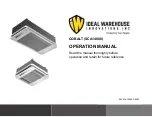
Flare nut
Cap
Valve body
Valve stem
3-way (gas) valve of
a circuit.
18.
Power up the system, and run the indoor unit for
circuit A in COOLING mode to verify that all functions
are working.
19.
Switch the indoor unit of circuit A to HEAT mode,
and verify that all functions are working.
20.
Set the temperature on remote to HIGHEST setting,
and while the unit is running in heat mode, check one
last time for leaks at all 4 related pipe connections of
circuit A. It is easier to catch the smallest leaks in HEAT
mode, as the pressures are much higher.
21.
If you discover a leak that cannot be stopped by
tightening the flare nuts at this stage, shut off both
2-way (liquid) and 3-way (gas) service valves, repair the
leak properly, and start from the beginning. Please
remember, you may need to add fresh refrigerant to the
system, as a significant value may be lost at this stage.
22.
REPEAT THIS ENTIRE PROCEDURE FOR THE
REMAINING CIRCUITS. Skip if a circuit is not being
utilized by an indoor unit to keep its circuit valves closed.
In case an indoor unit is added in the future, the same
procedure should be followed for that circuit entirely.
ADDING REFRIGERANT, IF THE TOTAL
REQUIRED VOLUME EXCEEDS THE
STANDARD FACTORY PRE-CHARGE
Your system is pre-charged with sufficient refrigerant to
work properly, according to an average length of 7.5 meter
(25 feet) piping for each of the available circuits (e.g. a 4
zone system can have a total piping length for all zones,
added together, of 30 meters (100 feet), max. If your total
piping length exceeds this limit, additional refrigerant
must be added to the system to compensate for the
difference (0.16 oz. per additional ft, for 1/4” liquid pipe
and 0.32 oz. per additional ft for 3/8” liquid pipe)
PROCEDURE FOR 3, 4, AND 5-ZONE OUTDOOR UNITS ARE
DIFFERENT FROM 2-ZONE MODELS. See the specific
instructions below for each type as it applies to your model.
1.
For dual (2-zone) systems, connect the low pressure hose
on your gauge manifold (usually blue) to the 3-way (gas)
valve’s service port of one of the occupied circuits
(Circuit A preferred). See the following drawing.
Page 23
2.
For 3, 4, and 5 zone systems, connect the low
pressure hose from the gauge manifold set (this is
usually the blue hose on most sets) to the 3-way
(gas) side valve of the common (master) circuit.
See below drawing.
3.
Connect the center hose of the gauge manifold
to the refrigerant container (usually the
yellow hose on most sets). Refrigerant R410a can
only be charged in liquid form, while the container
is inverted (upside down). Note that all
2-way (liquid) and 3-way (gas) service valves for
all “occupied” circuits, where an indoor unit is
attached, must be in the open position.
Additionally, for 3, 4, and 5 circuit models, the
common (master) 2-way (liquid) and 3-way (gas)
valves must also be in open position.
4.
The air trapped in the gauge manifold and the
hoses must be purged out. Use the pressure from
the system to purge the low side hose, by briefly
loosening its connection at the gauge manifold
for a moment. Next, open the valve of the
refrigerant container to pressurize the center
hose, and loosen the connector of the center hose
at the gauge manifold for a moment, and purge.
5.
Determine the total volume of the additional
refrigerant added into the system for the
additional piping.







































